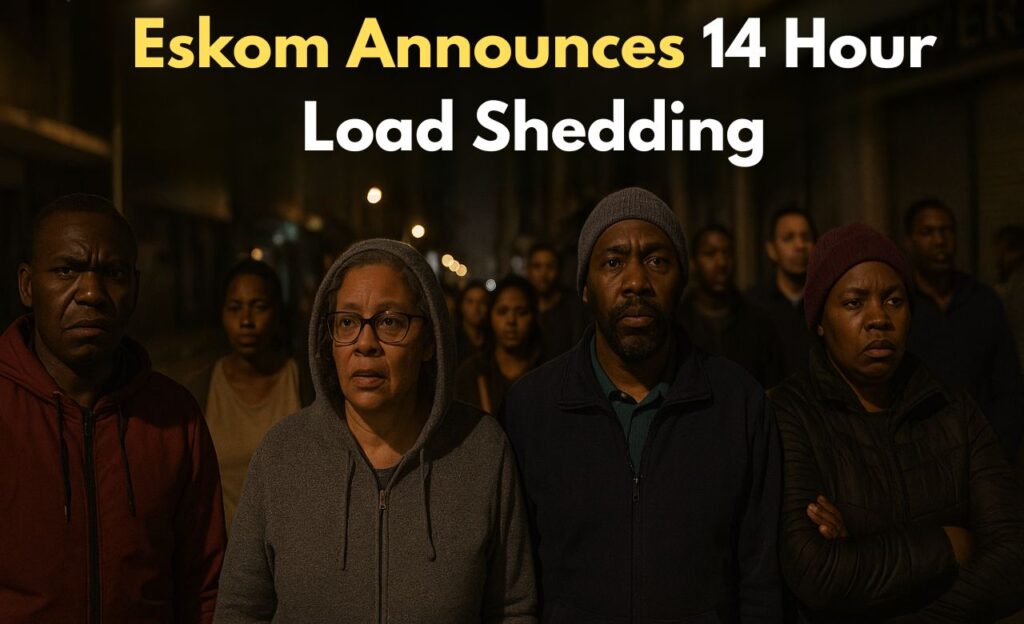South Africans are once again bracing for long hours of darkness as Eskom announces 14-hour load shedding across all provinces. This latest power cut schedule has affected both urban and rural regions, disrupting daily routines and businesses. The electricity supply crisis continues to challenge homes, hospitals, and small enterprises, forcing citizens to prepare backup options. With this extended outage, power restoration timelines remain uncertain as Eskom battles generation issues and maintenance delays. Here’s a detailed look at what’s happening, why it’s occurring, and what you can expect during this period.

Nationwide Power Cuts Announced by Eskom
The state-owned utility, Eskom South Africa, has declared a nationwide load shedding schedule due to persistent capacity shortages and unplanned breakdowns. The 14-hour blackouts are being rolled out in stages, with different provinces affected at alternating times. Citizens are urged to follow the Eskom load shedding timetable closely to plan their day effectively. Critical sectors like healthcare and transport have been prioritized, but many residential areas are facing multiple outages daily. Eskom has assured that it is taking measures to stabilize the grid while urging residents to reduce electricity usage wherever possible.
Read Also : November 2025 SASSA Grant Schedule for Retirees – Caregivers Checklist and Status for Individuals
Impact on Households and Businesses Across Provinces
The extended power outage duration is heavily impacting households, small businesses, and essential services across South Africa. Restaurants, grocery stores, and manufacturing plants are facing production delays and spoilage risks. In many provinces, backup generators and solar panels have become essential for survival. The load shedding crisis has also disrupted online learning, remote work, and banking services. Citizens are advised to prepare by charging devices, stocking candles, and keeping alternative cooking solutions ready. For many, this 14-hour blackout has become a serious test of resilience and planning.
Government and Eskom Response to Ongoing Blackouts
In response to the growing energy shortage, the South African government has announced plans to collaborate with independent power producers. Efforts are being made to expand renewable energy investments and upgrade aging infrastructure. Eskom officials have also launched urgent maintenance programs to prevent total grid collapse. Despite these efforts, many citizens remain skeptical, as frequent power failures continue to dominate daily life. Authorities have urged the public to stay informed through official channels and avoid misinformation circulating online regarding load shedding stages and restoration times.
Updated Load Shedding Schedule and Key Timings
The following table outlines the current load shedding schedule across South Africa. While exact timings may vary by region, this serves as a general guide for citizens to plan their power usage and activities. Eskom advises checking local municipality updates for precise information. Staying proactive and aware can help minimize disruption during these challenging hours of power outage.
| Province | Load Shedding Hours | Start Time | End Time | Stage |
|---|---|---|---|---|
| Gauteng | 14 Hours | 06:00 AM | 08:00 PM | Stage 6 |
| Western Cape | 13 Hours | 07:00 AM | 08:00 PM | Stage 5 |
| KwaZulu-Natal | 14 Hours | 05:00 AM | 07:00 PM | Stage 6 |
| Eastern Cape | 12 Hours | 08:00 AM | 08:00 PM | Stage 4 |
| Free State | 14 Hours | 06:00 AM | 08:00 PM | Stage 6 |
FAQ 1: What is the reason for the 14-hour load shedding?
It’s mainly due to generation unit breakdowns and insufficient supply capacity.
FAQ 2: Which areas are most affected by the power cuts?
Major urban centers like Johannesburg, Durban, and Cape Town are facing the heaviest power cuts.
FAQ 3: How can I check my local load shedding schedule?
Visit the Eskom website or use the official mobile app for updated schedules.
FAQ 4: Is there any relief expected soon?
Eskom is working on maintenance projects and renewable energy integration to ease the crisis.




